The Eurocom Sky X7C (Clevo P775TM1-G) Gaming Laptop Review: True Desktop Replacement
by Brett Howse on August 5, 2019 8:00 AM ESTDisplay Analysis
Eurocom offers a huge range of display choices on the Sky X7C, with the base model shipping with a 1920x1080 60 Hz IPS panel, but this resolution is offered in both 120 Hz and 144 Hz offerings, with the 120 Hz being TN and the 144 Hz being the excellent G-SYNC IPS we’ve tested on other current generation gaming laptops. If you’d like a bit higher resolution, there’s also a 2560x1440 120 Hz TN, or a 3840x2160 60 Hz IPS offering. They’ve really covered all of the bases and all of the price points.
The question of which display to get really comes down to personal preference, although the limitations of the underlying hardware is also a consideration. Since this is first and foremost a gaming notebook, if you do love gaming you likely want something with a higher refresh rate, and probably G-SYNC as well, so the 144 Hz IPS is a great choice, and one that we’ve tested on both the Acer Predator Triton 500 as well as the MSI GE75 Raider, and quite frankly, is an amazing display for gaming. If you really want UHD, the panel options are currently limited to 60 Hz, and as we just saw in the GPU performance section, even an RTX 2080 can struggle to game at that resolution with all of the game settings at maximum, so to spice things up a bit, we requested the QHD 120 Hz TN panel from Eurocom for this review. At QHD, you can still game with acceptable framerates, but obviously with the knowledge that it’s a TN display rather than the higher quality IPS offerings at both FHD and UHD resolutions. TN panels aren’t known for their amazing color accuracy, contrast, or viewing angles, but it is a way to get into a higher than 1080p gaming laptop that still has acceptable gaming potential.
![]() Subpixels showing the matte coating
Subpixels showing the matte coating
All of the displays from Eurocom are matte, and as a large form factor gaming notebook, they also do not include touch support.
Eurocom also offers a nice feature in their configuration options. You can have them color calibrate your display and they will include the ICC profile on a USB drive as a backup as well.
To see how the 2560x1440 TN panel performs, it was run through our custom workflow using Portrait Display’s CalMAN software suite, using an X-Rite i1Display Pro colorimeter for brightness and contrast measurements, and the X-Rite i1Pro2 spectrophotometer for color accuracy testing.
Brightness and Contrast
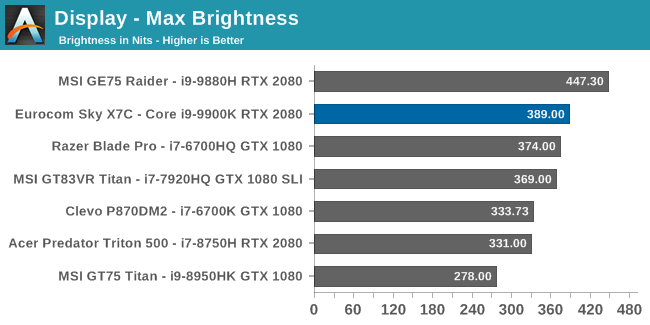
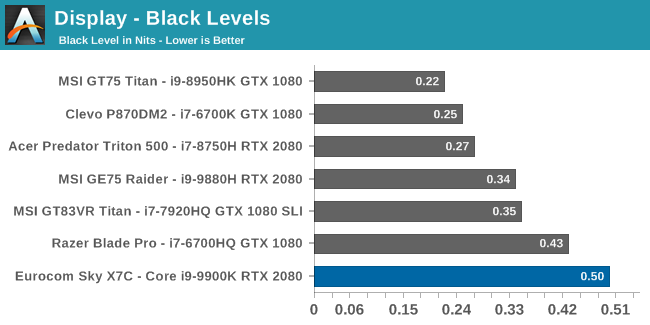
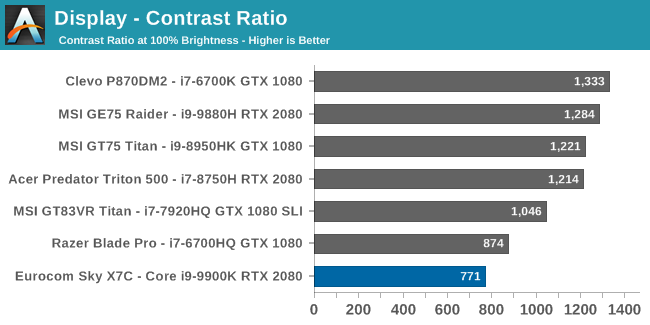
The TN display offers reasonable brightness, coming in close to 400 nits at 100%, but as is typical of a TN panel the contrast ratio is pulled down by a lot of backlight bleed. An average IPS in 2019 tends to be 1200:1 contrast or higher, and the QHD panel in our review unit didn’t even hit 800:1.
Grayscale
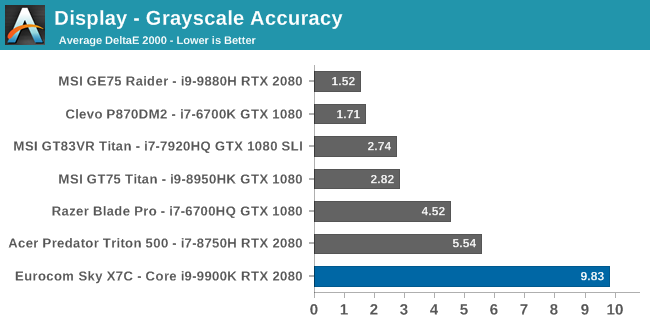
The error levels on the grayscale tests are massive, with an RGB imbalance that starts almost as soon as the display outputs any light, with the blue levels far higher than they should be. The gamma average is also too low, although across most of the spectrum it is actually pretty close to the 2.2 target.
Gamut
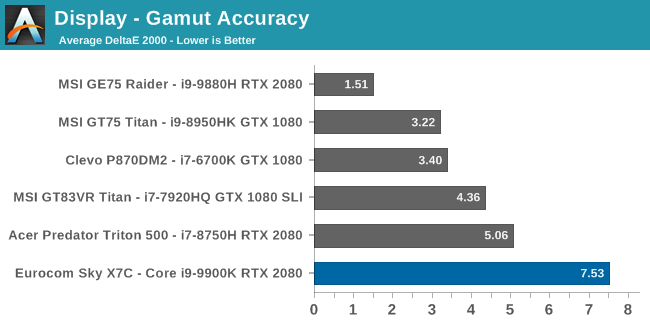
Testing the display at the 100% levels for the primary and secondary colors is unsurprisingly not really close to the targets when the blue levels are so high. Red and green are still off, but not by as much, but the blue levels really drag the blue secondaries out as well.
Saturation
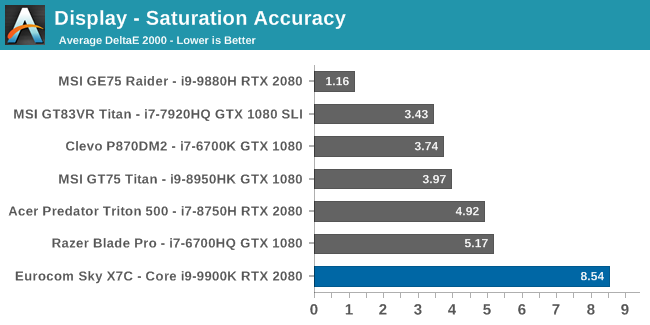
The difference between this test and the gamut test is that rather than just test at the 100% levels, the spectrum sweep tests each primary and secondary color at 4-bit steps across the entire range. To get a display we would consider accurate we’d want to see no points above the 3.0 error level, and unfortunately there are almost no points under that level.
Gretrag MacBeth
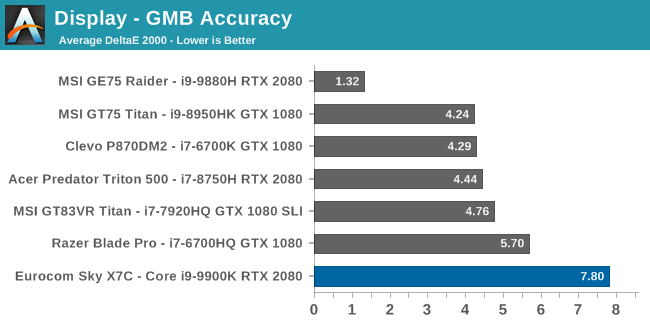
The final test covers a wide range of color points, not just the primary and secondary colors, and includes the very important skin tones. As before, we’re looking for results under the yellow line of 3.0 error level, and almost none of the color achieve that.
Colorchecker
This swatch shows the target color on the bottom half, and the measured color on the top, and really highlights just how blue this display is. The color accuracy is a complete mess.
Display Conclusions
We’ve tested the 1920x1080 144 Hz panel in two previous notebooks, and it is excellent. A 3840x2160 IPS display would offer exceptional clarity at the expense of gaming at the native resolution. As such, the 2560x1440 120 Hz TN display seemed like a good compromise of high refresh but higher resolution, but TN display tend to not offer the greatest results, and this TN panel in particular is one of the worst we’ve seen in some time.
Eurocom will color calibrate the display if you chose the option, but trying to reign in a display that is this far gone will generally cause its own issues with banding and clipping
If you really love QHD for gaming, and you like to run a 17.3-inch display at 100% with that resolution, then the option is here on this notebook, but after using it, seeing the poor contrast, the inaccurate colors, and the graininess that TN displays offer, the 144 Hz IPS really seems like the superior panel for gaming.















46 Comments
View All Comments
p1esk - Monday, August 5, 2019 - link
I love the option of 1440p at 120Hz! Hope to see it in normal laptops (perhaps new MBPs can lead the way to improved refresh rates?)HollyDOL - Monday, August 5, 2019 - link
Since the article title talks about 'true desktop replacement', could we get price and performance comparison to desktop with "same" parts? ie. DDR4-3000 + 9900K + RTX 2080...Brett Howse - Monday, August 5, 2019 - link
Our GPU bench is currently an i9-9900K as well. As a comparison I got 116 FPS on Shadow of the Tomb Raider, and Ryan got 114.6 with the desktop version, so the performance seems similar. Unfortunately we don't have a lot of overlap on our tests though because Ryan is able to keep GPUs and benchmark them on new suites whereas laptops have to go back to the manufacturers so I don't rotate the tests as heavily since every time I add a new test it starts out with zero results to compare against.Is there a particular title you'd like to see compared against other than Shadow of the Tomb Raider?
HollyDOL - Tuesday, August 6, 2019 - link
nice, thanks...Compile Chromium (time) test would be nice...
or in general anything that puts the machine under high sustained stress for longer period (45mins+)...
craz8 - Monday, August 5, 2019 - link
I have one of these laptops - a Sager branded one.It really is quite heavy, and the 330W power brick is equally beefy - I selected the RTX 2070 to avoid needing double power bricks. I do use this on my lap, but the power plug at the back falls out a lot in this configuration. It's not a very secure connection. Since it's at the back, the only way to notice is that suddenly the CPU is running at 1.3Ghz instead of 4+
I almost always run this in Quiet mode, as the fans are almost silent in this mode. When I'm stressing the machine, the CPU clocks down to about 3.4-3.6 Ghz, which is still good enough for the work I do on it. If I run in performance mode, the things I run go a little faster, but the fan noise is not worth the extra speed.
There really isn't enough cooling for Nvme drives. Even small amounts of writing to them immediately pushes the temps to 90+, and there's no room for extra heatsinks to help with this.
I have the 4K screen, which seems pretty good, but if you dual boot into a Linux OS, the bootloader screen is hilariously small, and some versions of Linux have poor scaling options
I mostly use this on my desk, and it (or Windows 10) really doesn't like my CalDigital TB3 dock. Luckily, everything plugs into the chassis (unlike recent Apple hardware)
I don't play games on this, so barely use the GPU (RTX 2070). I'd love to have options to push more power and cooling to the CPU whilst scaling them back to the GPU without having to poke at the values manually.
Overall, I like mine, but it does have quirks.
Alistair - Monday, August 5, 2019 - link
I think you'd be much better off with a (I hate to say it) nVidia creator laptop, or a 9880H/9980HK laptop with a 120/144hz Gsync IPS screen. We need a comparison with Clevo of the MSI Stealth and Raider and Titan.https://www.newegg.com/matte-black-with-gold-diamo...
Brahman05 - Monday, August 5, 2019 - link
I have sager's version of the x9e2 with a 7700k and 1080sli and the same 1440p panel, and the panel is both one of the best and worst parts in the thing. One thing not mentioned in this article is the gtg does not really support the refresh rate, but by reporting a 120hz refresh it at least still cuts down on input lag. I really have no complaints though. When I got it I had a mobile lifestyle and had the money for it, my only two real gripes are ZEN and RTx. Not 3 months after I got the thing AMD goes and makes 8c16t a thing and even if the architecture is pretry much the same from the 6700k to the 9900k the productivity of the same class chip is now double. And with RTX going to NVLink for an sli bridge Nvidia has axed mobile sli due to the complexity involved in producing that type of connector. So this X7c is really the way to go anymore. Damn you progress!LsRamAir - Monday, August 5, 2019 - link
No Overclocking detail... bahhhh! Pushing these DTRs to the max that their cooling allows for is what at least half of their buyers do... Next time, yes please! (Especially in the wake of similarly spec'd DTR machines burning out under mild OC's, which SHOULD NOT HAPPEN, it would be nice to know if this SKY is also part of the bad choices group.)peteraustin - Tuesday, August 6, 2019 - link
Amazing article https://www.anandtech.com/ you should definitely read it in your spare timehennes - Tuesday, August 6, 2019 - link
I recently got this laptop as a replacement for a 10 1/2-year-old laptop. I wanted a full-sized keyboard, which means 17” or larger. Potable means 17” really it the limit. And 17” is perfect for 2k screens.The Sky X7 was one of the few which offered that and it had all my desired other connectivity (multiple NVME, multiple DP out, a few fast USB ports, thunderbolt, …
What really was surprising is how few other there are. Many with low res displays (1920x1080) which makes sense for gaming. Some with 4K displays future proof but quite small on a 17” display.
That made the X7C almost the only sensible choice.
And from an engineering view the thicker than average body was also very attractive. As were the looks. Form over function simply looks good, while designed stuff tend to look odd and twisted to me.
The only thing it lacks for me is more battery capacity. Lugging the large charger around is not fun and two battery slots (or 2x 80) for airplane use would have been my choice if it was offered.